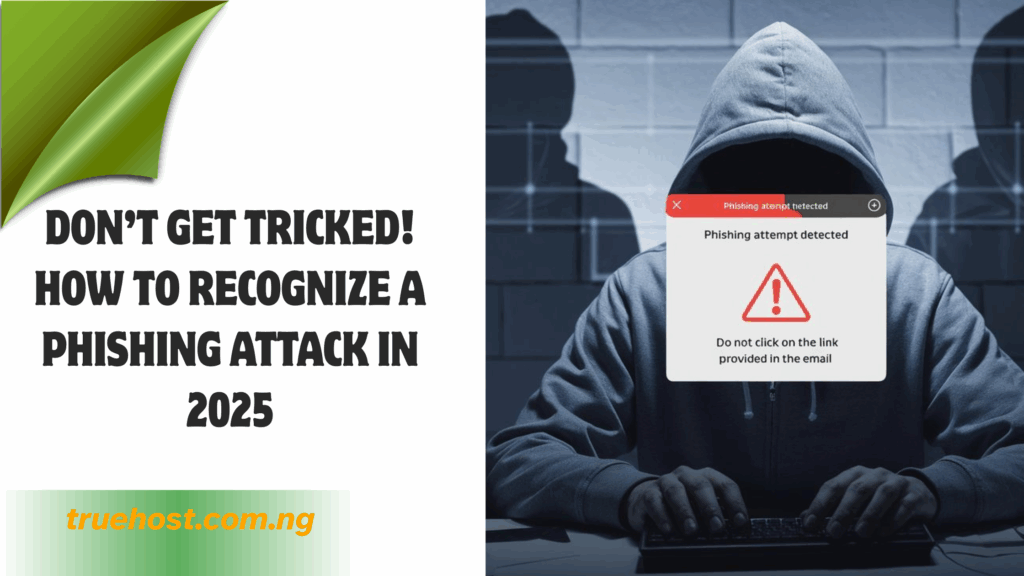Every time you open your email inbox, you are actually taking a small risk. One wrong click, one rushed decision and you could be handing over your most sensitive information to a cybercriminal. In 2025, the stakes are higher than ever. The phishing attacks have become so clever that even the most cautious people are falling victim.
It is no longer about the laughable obvious scams that promise you a million naira. Today these attacks have been carefully crafted into a trap that is designed to look real, feel urgent and even slip through even advanced spam filters.
The scary truth is that these cybercriminals are evolving just as fast as the technology that is meant to stop them. And while most people assume that they would never fall victim to such scams, the numbers are telling a completely different story.
So, let us take a pause and walk through how phishing attacks have evolved, the red flags you need to look out for and how you can protect yourself from them.
What Is Phishing And Why It’s Still a Top Threat
Phishing attacks are deceptively simple. It usually starts with a message delivered through the most trusted tool most of us rely on every day, email. This message is set in such a way that it convinces you to hand over either personal details, financial data or even login credentials.
Sometimes it comes in the form of a fake link that directs you to a counterfeit website. Other times it is an attachment carrying a malicious code.
Now, you might think, “But I’m careful, I’d never fall for that.” The fact remains that phishing attacks work on millions of people daily. They are crafted in such a way that they bypass your logic and strike your emotions, be it fear, urgency, or even curiosity.
I mean, the numbers are staggering:
- An estimated number of 3.4 billion phishing emails are sent every single day, which totals to roughly 1.2% of all global email traffic.
- It has also been seen that 36% of all data breaches involve phishing attacks, making it one of the most consistent cybercrime tactics worldwide.
- And here is one that should keep you on your toes, 94% of malware still comes from phishing emails.
That means that almost every time someone downloads a malicious file or accidentally installs some harmful software, the root cause was probably a phishing attack that looked like a harmless email.
Think about it for a second, in Nigeria alone, where many businesses are relying on online transactions and fintech apps, the cost of a single phishing click could be dire.
In fact, local reports show that Nigerian businesses lose millions annually to Business Email Compromise (BEC), a highly targeted form of phishing where criminals impersonate CEOs or vendors to authorize fraudulent transactions.
New & Sneaky Phishing Attacks Techniques You Need to Know
Gone are the days when phishing meant a poorly written email full of grammatical errors. In 2025, phishing attacks are more innovative than ever. With them blending psychology, AI and technology. Below are some of the most dangerous new tactics you should watch out for, and yes, they are reaching Nigeria too.
1) QR Code Phishing (Quishing)
These days, cybercriminals are aware that people are now wary of clicking any random links. Their solution? QR codes.
Phishers are now embedding QR codes inside emails or PDF attachments. You scan it with your phone expecting maybe a payment confirmation but instead you are taken to a fake login page that looks legitimate but it silently steals your credentials.
The worst part is that security scanners often do not detect these codes, making Quishing harder to stop.
Actually, this year, in just three months, over 500,000 malicious PDFs containing QR codes were detected worldwide.
2) Phishing-as-a-Service (PhaaS)
This one is chilling. Before, phishing attacks used to require skills to carry out successfully. Now, anyone can pay for ready made phishing kits.
Just like you can subscribe to Netflix, cybercriminals can now subscribe to platforms like EvilProxy or Tycoon 2FA that give them these kits. These services come with customer support and even tutorials for scammers. And even more shockingly is that these templates can bypass multi-factor authentication(MFA).
It is no wonder that in just two months over one million PhaaS attacks were recorded.
3) AI-Powered Personalized Phishing
Believe it or not but Artificial Intelligence is not just helping businesses but criminals too.
Attackers are using AI to scan your social media, emails, and even company websites to craft eerily convincing messages.
And if you think it is a joke, studies have shown that AI-written phishing emails had a 54% click-through rate which is 350% higher than generic spam.
Imagine getting a business email that uses your exact communication style, references your recent project and even mimics your boss’s tone.
4) Smishing and Vishing
We are now living in an era where phishing attacks are no longer trapped in our email inbox. Actually, around 28% of phishing attacks now occur via SMS(smishing). You might receive a text claiming your BVN needs verification, or that your delivery requires a small payment.
At the same time, phone-based scams(vishing) have jumped to 260% since 2022. Scammers call pretending to be service agents and pressure victims into revealing account details.
The creativity behind these scams shows why vigilance is crucial.
Spotting the Red Flags Before It is Too Late
So, how do you keep yourself from becoming the next victim? Spotting the subtle signs of phishing attacks is your first line of defense. Watch out for:
- Unusual urgency: Messages claiming your account will be locked within minutes.
- Generic greetings like “Dear Customer,” rather than using your real name.
- Mismatched links: Hover over the link before clicking, if it doesn’t match, it is a red flag.
- Unexpected Attachments or QR codes where plain links would suffice.
- Suspicious sender addresses: A tiny spelling difference in a domain like “paypall.com” instead of “paypal.com” can trick the eye.
- Requests for sensitive data, like OTPs, PINs, or login credentials.
- Offers that feel too good to be true, because they usually are.
Learning these cues isn’t paranoia, it is survival in today’s digital age.
What Really Happens If You Click That Link?
Assuming that you slip and click that link. What is the worst that could happen?
Unfortunately, the answer is, quite a lot. Modern phishing attacks don’t simply steal your password, nope, they hijack your entire session. Tools like Evilginx are capable of launching man-in-the-middle attacks that can harvest your login credentials in seconds. The scary part is they can even bypass multi-factor authentication(MFA) and steal the one-time codes without you realizing it.
This means you could have an OTP, Face ID, or fingerprint enabled, and they can still get in. Once inside, these attackers can:
- Gain full access to your accounts, leading to financial theft or unauthorized purchases.
- Businesses can face data breaches, regulatory penalties, and reputational damage.
- Lock you out of your accounts by changing recovery details.
- Spread the attack to your contacts, making you the unknowing accomplice.
And the worst part? Victims often don’t realize what happened until it is too late.
How to Stay Safe From Phishing Attacks in 2025
While phishing attackers are evolving, so are the defenses available to you. Here is what works:
- Enable Multi-Factor Authentication (MFA): It is not perfect, but it still adds a solid extra layer.
- Scrutinize Every Email: Especially those involving money, logins, or urgency.
- Use Email Authentication Protocols: SPF, DKIM, and DMARC help block spoofed emails. Shockingly, only 7.7% of domains worldwide enforce DMARC properly.
- Try Email Hosting: Email hosting solutions often include AI-driven spam and phishing filters, encrypted communication, and features like SPF, DKIM, and DMARC.
- Invest in Email Security Tools: AI-powered email filters, secure gateways, and browser isolation drastically reduce risks.
- Stay Updated and Aware: Most importantly, keep yourself and your team informed. Knowledge is the best filter you can’t buy.
- Report Suspicious Emails: Services like Google Safe Browsing help track and reduce global phishing campaigns.
- Educate yourself and your team: Phishing awareness training reduces risks dramatically.
Bringing It Home
No one wakes up planning to fall for a phishing attack. It often happens when you are stressed, distracted, or in a hurry. But the truth is, awareness plus secure infrastructure can dramatically cut your risk.
For many people, it means fewer worries about your bank accounts or social media being hijacked. For businesses, it means preventing costly breaches, protecting client trust, and keeping operations smooth.
That is why securing your inbox is not a luxury, it is a necessity. With Truehost’s email hosting, you are not just getting professional communication tools. You are getting advanced phishing filters, authentication protocols, and a reliable infrastructure designed to keep you and your business safe in a world where cybercriminals never sleep.
So, the real question is, will you wait until a phishing attack hits your inbox, or will you take action today to protect yourself and your business?
Stay smarter. Stay safer. Secure your email hosting with Truehost now.

